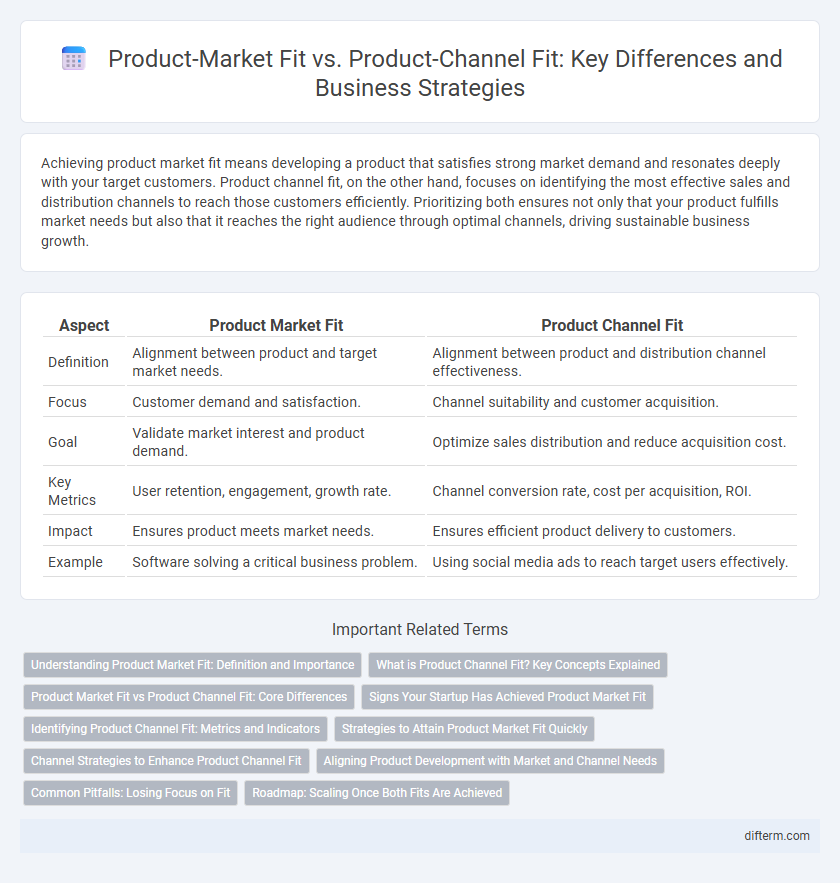Achieving product market fit means developing a product that satisfies strong market demand and resonates deeply with your target customers. Product channel fit, on the other hand, focuses on identifying the most effective sales and distribution channels to reach those customers efficiently. Prioritizing both ensures not only that your product fulfills market needs but also that it reaches the right audience through optimal channels, driving sustainable business growth.
Table of Comparison
| Aspect | Product Market Fit | Product Channel Fit |
|---|---|---|
| Definition | Alignment between product and target market needs. | Alignment between product and distribution channel effectiveness. |
| Focus | Customer demand and satisfaction. | Channel suitability and customer acquisition. |
| Goal | Validate market interest and product demand. | Optimize sales distribution and reduce acquisition cost. |
| Key Metrics | User retention, engagement, growth rate. | Channel conversion rate, cost per acquisition, ROI. |
| Impact | Ensures product meets market needs. | Ensures efficient product delivery to customers. |
| Example | Software solving a critical business problem. | Using social media ads to reach target users effectively. |
Understanding Product Market Fit: Definition and Importance
Product Market Fit (PMF) occurs when a product satisfies strong market demand, reflected by high customer retention, rapid growth, and positive user feedback. Achieving PMF indicates that the product effectively addresses target customer needs, driving scalable business success and competitive advantage. Companies prioritize PMF to validate product viability before scaling marketing efforts and optimizing distribution channels.
What is Product Channel Fit? Key Concepts Explained
Product Channel Fit refers to the alignment between a product and the most effective distribution channels that deliver it to the target customers, maximizing reach and sales. Key concepts include understanding customer behavior within specific channels, channel economics, and tailoring marketing strategies to leverage each channel's strengths. Achieving Product Channel Fit ensures efficient customer acquisition and sustainable growth by optimizing how and where the product is marketed and sold.
Product Market Fit vs Product Channel Fit: Core Differences
Product Market Fit (PMF) centers on ensuring a product meets the demands and pain points of a target market segment, validating that customers desire and will pay for the product. Product Channel Fit focuses on identifying and optimizing the communication and distribution channels through which the product reaches customers effectively and efficiently. The core difference lies in PMF addressing customer needs and market demand, while Product Channel Fit addresses the strategic pathways for delivering the product to those customers.
Signs Your Startup Has Achieved Product Market Fit
Signs your startup has achieved Product Market Fit include consistently high user engagement and rapid organic growth driven by customer referrals. Customers demonstrate strong retention rates and actively provide positive feedback and feature requests, indicating your product effectively solves their core problems. Revenue metrics improve steadily, with decreasing customer acquisition costs and increasing lifetime value, signaling market demand aligns with your product offering.
Identifying Product Channel Fit: Metrics and Indicators
Identifying Product Channel Fit involves measuring key metrics such as customer acquisition cost (CAC), conversion rates, and customer lifetime value (CLV) across different distribution channels to determine the most effective paths for scaling. Monitoring engagement metrics like click-through rates (CTR) and channel-specific retention rates provides insights into which channels resonate best with the target audience. Analyzing these indicators helps businesses optimize marketing spend, improve channel strategy, and achieve sustainable growth.
Strategies to Attain Product Market Fit Quickly
To attain Product Market Fit quickly, concentrate on identifying a clear target audience and iterating the product based on direct user feedback and engagement metrics. Employ focused market segmentation and prioritize features that solve pressing pain points, ensuring rapid validation through minimum viable products (MVPs) and A/B testing. Leveraging data-driven customer acquisition strategies alongside close collaboration with early adopters accelerates alignment between product offerings and market demand.
Channel Strategies to Enhance Product Channel Fit
Effective channel strategies enhance Product Channel Fit by aligning distribution methods with target customer behaviors and preferences, ensuring seamless access and engagement. Leveraging multi-channel approaches, such as direct sales, digital platforms, and strategic partnerships, optimizes reach and boosts adoption rates. Data-driven channel optimization and continuous feedback loops enable adaptive refinement of channel tactics to drive sustainable growth and higher conversion rates.
Aligning Product Development with Market and Channel Needs
Product Market Fit identifies the ideal customer segment that resonates with the core product value, ensuring demand validation and user satisfaction. Product Channel Fit emphasizes selecting and optimizing distribution pathways such as e-commerce platforms, retail, or direct sales to match channel dynamics and audience behavior. Aligning product development with both market preferences and channel capabilities drives scalable growth, minimizes customer acquisition costs, and enhances long-term revenue streams.
Common Pitfalls: Losing Focus on Fit
Losing focus on achieving product market fit often results in misaligned customer needs and stagnant growth, while neglecting product channel fit can cause ineffective distribution and wasted marketing resources. Common pitfalls include prematurely scaling without validating core demand or choosing channels that do not resonate with target audiences, leading to costly customer acquisition failures. Ensuring a balanced emphasis on both product market fit and product channel fit maximizes sustainable business scalability and revenue generation.
Roadmap: Scaling Once Both Fits Are Achieved
Achieving both product-market fit and product-channel fit is crucial before scaling to ensure sustainable growth and efficient resource allocation. The roadmap to scaling involves refining the product based on validated customer feedback while optimizing distribution channels to maximize reach and conversion rates. Prioritizing these fits minimizes churn and accelerates market penetration through aligned product features and channel strategies.
Product Market Fit vs Product Channel Fit Infographic

 difterm.com
difterm.com